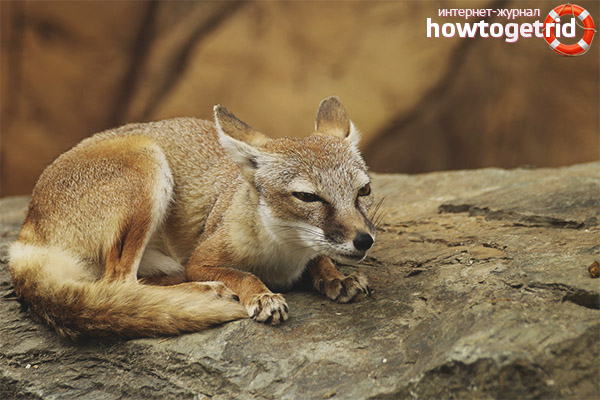The content of the article
A beast widespread in nature called the fox is familiar to many from Russian folk tales, where it acts as a sly fox. This animal is divided into many species. One of them is a corsac living in the steppe.
Description
- Korsak - one of the species of foxes, belongs to the canine family.
- The dimensions are modest, not very impressive - the length is only 45-70 centimeters, the height is slightly more than 30 centimeters. The tail is slightly shorter than the body - about 40 centimeters. The weight of an adult fox is from 4 to 7 kilograms.
- The head is small, the muzzle is pointed. The nose is dark, the eyes are green with yellow, the mouth adorns many small but sharp teeth, there are 48 of them. Paws high with bent claws. Like any predator, it has well-developed hearing, smell and vision.
- The fur is gray with a red or yellow tint. This color allows you to successfully merge with the steppe landscape, which helps in hunting and helps to survive.
- Chest, throat and abdomen are covered with lighter fur. At the tip of the tail it is dark.
- Like most predators, depending on the season, the fur coating undergoes changes. In summer it is dark and short, and in winter it becomes long, dense and more attractive, acquiring a yellowish-grayish color. And the fur turns gray on the ridge, giving the fox a peculiar look.
- They run quite fast - they can reach speeds of up to fifty kilometers per hour. Plus, the corsac is endowed with the ability to climb trees.
Habitat and Behavior
On the Russian territory lives in almost all steppe zones: there are a lot of steppe foxes in the North Caucasus, near the Don, southern regions of the Urals. Several individuals live in the Transbaikal steppes. Some representatives of the species are seen in the Ukrainian steppes.
Fact! Usually Korsaks avoid forests, but live in the forest-steppe. Mountains are also avoided without rising above the foothills.
Korsaki choose a hilly area devoid of vegetation for housing. The reason for choosing is simple - in winter there will be a lot of snow on such a surface, which is easier to hide in.
Each beast has an area of about 30 square kilometers. On it at the beast there are several holes lovingly equipped with a fox. But she didn’t dig them at all (she independently digs in very rare cases). Justifying the title of a cunning beast, the corsac expels rodents from the burrows of the type of badgers, ground squirrels or columns, and settles in their dwellings. Fortunately, the sizes are suitable.
May occupy a home abandoned by a large fox. Typically, the burrows of the steppe fox are connected to each other, in one of them the corsac spends time. As a rule, in the standard hole there are several exits - their number can be up to five pieces.
Korsak leads a nocturnal lifestyle, begins to hunt with the onset of twilight. Prefers to do this alone, but sometimes arranges group hunting, the size of the group can be large and reach 40-45 individuals.
If there is severe frost on the street or a storm is rampant, then the hunt is canceled, the fox stays in the hole for up to three days in a row - such a long absence of food does not bother her.
Food

Steppe foxes feed mainly on animal food. The basis of the diet is small rodents, jerboas, birds and their masonry. If there is nothing to eat, do not pass by carrion.
When for some reason they eat vegetation tightly, without problems, they destroy any vegetables and fruits and eat herbs. This also brings some benefit - the body restores vitamin balance.
When a lot of snow falls, and the corsac begins to mingle in it, foxes roam closer to human settlements. Often Korsaks can be seen there next to human dwellings, where they find food in landfills and arrange hunting for domesticated birds.
It is also worth noting that although Korsak lives in a dry climate that causes dehydration, it practically does not drink water. The right amount of moisture is obtained from the food used in food and the body has enough.
Breeding
Steppe foxes become sexually mature at the 9-10th month of life, and can continue the genus already in the second year.
Korsaki are loyal to their life partner - they choose a couple once and for all. When choosing a partner, the males arrange fierce battles.
The mating season begins in late winter - early spring. Pregnancy lasts about two months. From 3 to 6 cubs are born at a time. They are blind, the body is covered with short light brown hair. They feed on mother's milk for up to 2 months, but the father also takes care of the offspring, bringing to the children in the second month pieces of meat.
In about a month and a half, foxes are already able to leave their homes and go to the surface, getting used to the world around them. In the seventh month, having reached the size of their parents, they leave the house and begin to equip their lives.
Why the number of steppe foxes is constantly changing
Enemies
The main enemies of Korsak are wolves. Although the steppe fox runs very fast, it soon overtakes fatigue, and it slows down. And the gray predator is famous for its indefatigability and overtakes the fox. Another enemy is the fox. She is stronger and more agile, and since she and Korsak have the same diet, the steppe fox often loses and is hungry.
Video: steppe fox (Vulpes corsac)










Submit